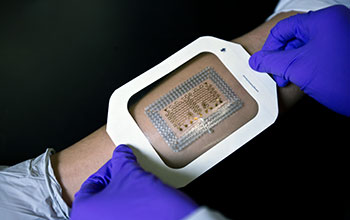Multimedia Gallery
Inexpensive method for making wearable patches developed
A research team at the Cockrell School of Engineering at The University of Texas at Austin have developed a faster, inexpensive method for making wearable patches that can continuously monitor the body's vital signs for health and performance tracking, potentially outperforming traditional monitoring tools such as cardiac event monitors.
Led by Assistant Professor Nanshu Lu, the teams manufacturing method aims to construct disposable, tattoo-like health monitoring patches for the mass production of epidermal electronics, a popular technology that Lu helped develop in 2011.
The team's repeatable, "cut-and-paste" method cuts manufacturing time from several days to only 20 minutes.
"One of the most attractive aspects of epidermal electronics is their ability to be disposable," Lu said. "If you can make them inexpensively, say for $1, then more people will be able to use them more frequently. This will open the door for a number of mobile medical applications and beyond."
The research was funded by grants from the National Science Foundation, including a Faculty Early Career Development (CAREER) award given to Lu.
To learn more about this research, see the UA Fairbanks news story Wearable electronic health patches may now be cheaper and easier to make. (Date image taken: unknown; date originally posted to NSF Multimedia Gallery: Nov. 30, 2015)
Credit: Cockrell School of Engineering
See other images like this on your iPhone or iPad download NSF Science Zone on the Apple App Store.
Images and other media in the National Science Foundation Multimedia Gallery are available for use in print and electronic material by NSF employees, members of the media, university staff, teachers and the general public. All media in the gallery are intended for personal, educational and nonprofit/non-commercial use only.
Images credited to the National Science Foundation, a federal agency, are in the public domain. The images were created by employees of the United States Government as part of their official duties or prepared by contractors as "works for hire" for NSF. You may freely use NSF-credited images and, at your discretion, credit NSF with a "Courtesy: National Science Foundation" notation.
Additional information about general usage can be found in Conditions.
Also Available:
Download the high-resolution JPG version of the image. (10.7 MB)
Use your mouse to right-click (Mac users may need to Ctrl-click) the link above and choose the option that will save the file or target to your computer.



